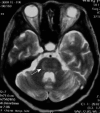Therapy of central pontine myelinolysis following living donor liver transplantation: Report of three cases
- PMID: 19701983
- PMCID: PMC2731265
- DOI: 10.3748/wjg.15.3960
Therapy of central pontine myelinolysis following living donor liver transplantation: Report of three cases
Abstract
We analyzed the clinical manifestations and experiences of diagnosing and treating central pontine myelinolysis following living donor liver transplantation. The clinical data of three patients with central pontine myelinolysis following living donor liver transplantation from January 2005 to November 2007 were retrospectively analyzed at the West China Hospital, Sichuan University, China. The three patients developed hyponatremia prior to surgery. Case 1 suffered locked-in syndrome following surgery, and received a large dose of gamma globulin, and subsequently recovered. Case 2 was in a coma for three days, and received hyperbaric chamber treatment. This patient remained in a mild coma for six months following surgery. Case 3 developed consciousness disturbances, gradually went into a coma following surgery, and died due to pulmonary infection. Central pontine myelinolysis is a severe complication in patients following living donor liver transplantation. Large-dose gamma globulin treatment, as well as hyperbaric oxygen, might be effective therapeutic methods.
Figures
Similar articles
-
Central Pontine Myelinolysis After Living-Donor Liver Transplant: A Report of 2 Cases.Exp Clin Transplant. 2019 Aug;17(4):564-567. doi: 10.6002/ect.2017.0060. Epub 2017 Nov 15. Exp Clin Transplant. 2019. PMID: 29137593
-
Central pontine myelinolysis after living donor liver transplantation.Hepatogastroenterology. 2004 Jan-Feb;51(55):247-8. Hepatogastroenterology. 2004. PMID: 15011876
-
Central pontine and extrapontine myelinolysis: a rare and fatal complication after liver transplantation.Transplant Proc. 2011 Jul-Aug;43(6):2237-8. doi: 10.1016/j.transproceed.2011.06.052. Transplant Proc. 2011. PMID: 21839243
-
[Progress in the etiology, diagnosis and treatment of central pontine myelinolysis in the postoperative period of liver transplantation].Zhonghua Yi Xue Za Zhi. 2004 Jun 17;84(12):1052-4. Zhonghua Yi Xue Za Zhi. 2004. PMID: 15312549 Review. Chinese. No abstract available.
-
Central pontine myelinolysis following pediatric living donor liver transplantation: a case report and review of literature.Pediatr Transplant. 2014 Jun;18(4):E120-3. doi: 10.1111/petr.12255. Epub 2014 Apr 12. Pediatr Transplant. 2014. PMID: 24725019 Review.
Cited by
-
Application of hyperbaric oxygen in liver transplantation.Med Gas Res. 2016 Dec 30;6(4):212-218. doi: 10.4103/2045-9912.196903. eCollection 2016 Oct-Dec. Med Gas Res. 2016. PMID: 28217293 Free PMC article. Review.
-
Recovery of locked-in syndrome following liver transplantation with calcineurin inhibitor cessation and supportive treatment.Am J Case Rep. 2013;14:16-9. doi: 10.12659/AJCR.883748. Epub 2013 Jan 24. Am J Case Rep. 2013. PMID: 23569555 Free PMC article.
References
-
- Abbasoglu O, Goldstein RM, Vodapally MS, Jennings LW, Levy MF, Husberg BS, Klintmalm GB. Liver transplantation in hyponatremic patients with emphasis on central pontine myelinolysis. Clin Transplant. 1998;12:263–269. - PubMed
-
- Lui CC, Chen CL, Chang YF, Lee TY, Chuang YC, Hsu SP. Subclinical central pontine myelinolysis after liver transplantation. Transplant Proc. 2000;32:2215–2216. - PubMed
-
- Ayus JC, Krothapalli RK, Armstrong DL. Rapid correction of severe hyponatremia in the rat: histopathological changes in the brain. Am J Physiol. 1985;248:F711–F719. - PubMed
-
- Lee YJ, Lee SG, Kwon TW, Park KM, Kim SC, Min PC. Neurologic complications after orthotopic liver transplantation including central pontine myelinolysis. Transplant Proc. 1996;28:1674–1675. - PubMed
Publication types
MeSH terms
Substances
LinkOut - more resources
Full Text Sources
Medical



